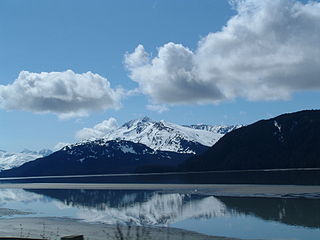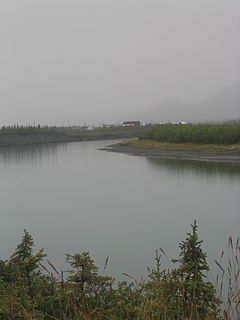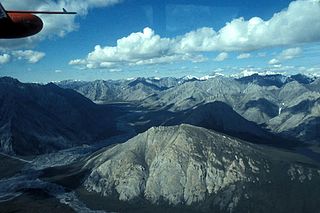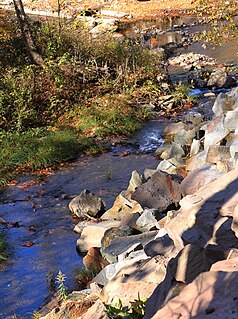This article needs additional citations for verification .(August 2007) (Learn how and when to remove this template message) |
| Killik River | |
|---|---|
| Location | |
| Country | United States |
| State | Alaska |
| Borough | North Slope, Yukon–Koyukuk Census Area |
| Physical characteristics | |
| Source | Confluence of April and Kakivilak creeks |
| - location | Gates of the Arctic National Park, Brooks Range, Yukon–Koyukuk Census Area |
| - coordinates | 67°46′09″N154°32′54″W / 67.76917°N 154.54833°W [1] |
| - elevation | 4,863 ft (1,482 m) [2] |
| River mouth | Colville River |
| - location | 52 miles (84 km) southwest of Umiat, North Slope Borough |
| - coordinates | 69°00′26″N153°54′35″W / 69.00722°N 153.90972°W Coordinates: 69°00′26″N153°54′35″W / 69.00722°N 153.90972°W [1] |
| - elevation | 548 ft (167 m) [1] |
| Length | 105 mi (169 km) [1] |
The Killik River[ pronunciation? ] is a 105-mile (169 km) tributary of the Colville River in the U.S. state of Alaska. [1] It begins in the northern portion of Gates of the Arctic National Park and flows north onto property of the Arctic Slope Regional Corporation. [3]
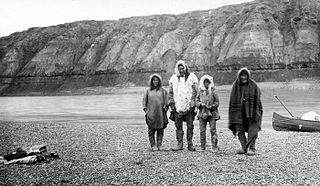
The Colville River is a major river of the Arctic Ocean coast of Alaska in the United States, approximately 350 miles (560 km) long. One of the northernmost major rivers in North America, it drains a remote area of tundra on the north side of the Brooks Range entirely above the Arctic Circle. The river is frozen for more than half the year and floods each spring.

In the United States, a state is a constituent political entity, of which there are currently 50. Bound together in a political union, each state holds governmental jurisdiction over a separate and defined geographic territory and shares its sovereignty with the federal government. Due to this shared sovereignty, Americans are citizens both of the federal republic and of the state in which they reside. State citizenship and residency are flexible, and no government approval is required to move between states, except for persons restricted by certain types of court orders. Four states use the term commonwealth rather than state in their full official names.
The river's headwaters are near Survey Pass in the Endicott Mountains on the north slope of the central Brooks Range, and the river mouth is south of Angoyakvik Pass. [4] The direction of the headwaters stream is northwest at first, then sharply northeast before April and Easter creeks enter from the right slightly north of the North Slope Borough boundary. [4] The river continues northeast for much of its course until it turns northwest again on the lower reaches after receiving the Okokmilaga River from the right. [4]

The Endicott Mountains are a range of mountains, part of the Brooks Range in northern Alaska. They are located in the middle of the Brooks range and run some 151 miles (243 km) east–west. To the east are the Philip Smith Mountains and to the west are the Schwatka Mountains. The Endicott Mountains are separated from the Philip Smith Mountains by the Middle Fork of the Koyukuk River, the Dalton Highway, and Atigun Pass. The Endicott Mountains are separated from the Schwatka Mountains by Walker Lake, the upper reaches of the West Fork of the Kobuk River, Akabluak Pass, and the Noatak River. The Endicott Mountains are separated from the mountains north of the Schwatka by Lucky Six Creek, Gull Pass, Gull Creek, a portion of the Alatna River and the Killik River.

The Brooks Range is a mountain range in far northern North America stretching some 700 miles (1,100 km) from west to east across northern Alaska into Canada's Yukon Territory. Reaching a peak elevation of 8,976 feet (2,736 m) on Mount Isto, the range is believed to be approximately 126 million years old.
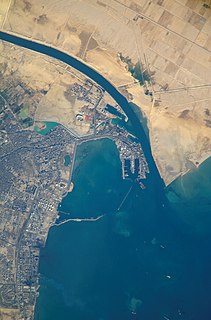
A river mouth is the part of a river where the river debouches into another river, a lake, a reservoir, a sea, or an ocean.
Major tributaries of the Killik are April and Easter creeks, as well as the Okokmilaga. [4] North of Easter Creek, tributary streams, such as Aniakvik Creek and Nigaktukvik Creek, flow predominantly through short, narrow, V-shaped valleys.
The main stem flows down a U-shaped glacial valley containing lakes, sand dunes, lateral moraines, and alpine tundra. [5] This valley, about 2 miles (3 km) wide initially, widens to between 3 and 5 miles (5 and 8 km) on the lower reaches, and the river becomes braided. [5] Copious stretches of dwarf birch (betula nana), and sedges, with large expanses of sedge bogs and tussocks dominate the tundra.

In hydrology, a main stem is "the primary downstream segment of a river, as contrasted to its tributaries". Water enters the main stem from the river's drainage basin, the land area through which the main stem and its tributaries flow. A drainage basin may also be referred to as a watershed or catchment.

In physical geography, tundra is a type of biome where the tree growth is hindered by low temperatures and short growing seasons. The term tundra comes through Russian тундра from the Kildin Sami word тӯндар meaning "uplands", "treeless mountain tract". Tundra vegetation is composed of dwarf shrubs, sedges and grasses, mosses, and lichens. Scattered trees grow in some tundra regions. The ecotone between the tundra and the forest is known as the tree line or timberline.
![Braided river A network of river channels separated by small, and often temporary, islands called [[braid bar]]s](https://upload.wikimedia.org/wikipedia/commons/thumb/3/35/Waimakariri01_gobeirne.jpg/320px-Waimakariri01_gobeirne.jpg)
A braided river, or braided channel, consists of a network of river channels separated by small, often temporary, islands called braid bars or, in British usage, aits or eyots. Braided streams occur in rivers with low speed, low slope, and/or large sediment load. Braided channels are also typical of environments that dramatically decrease channel depth, and consequently channel velocity, such as river deltas, alluvial fans, and peneplains.
The Killik is fed largely by precipitation and snow melt, and hence its waters are relatively clear of the sediment that characterizes glacial streams.


